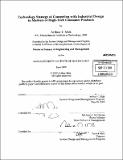| dc.contributor.advisor | Michael A. M. Davies. | en_US |
| dc.contributor.author | Mak, Arthur T | en_US |
| dc.contributor.other | System Design and Management Program. | en_US |
| dc.date.accessioned | 2010-05-25T21:06:45Z | |
| dc.date.available | 2010-05-25T21:06:45Z | |
| dc.date.copyright | 2009 | en_US |
| dc.date.issued | 2009 | en_US |
| dc.identifier.uri | http://hdl.handle.net/1721.1/55225 | |
| dc.description | Thesis (S.M.)--Massachusetts Institute of Technology, System Design and Management Program, 2009. | en_US |
| dc.description | Cataloged from PDF version of thesis. | en_US |
| dc.description | Includes bibliographical references (p. 74-83). | en_US |
| dc.description.abstract | This thesis explores the role of industrial design in the formulation of technology strategy for certain firms that compete in markets of high-tech consumer products. The initial intuition is that the role of industrial design becomes more important at mature stages of the product evolution cycle. Industrial design makes products more user-friendly and attractive, which are highly valued by later stage, mainstream users. Successes of such firms are largely dependent on user's experiences of the firms' products. A utility-based concept model is created to formalize four components that are responsible for user's experience: functional performance (how well it does its job), capability (what jobs can the product do), usability (how easy to use the product to do its Cajnobd), aestetics (how externally beautiful is the product). The concept model is then converted into a testable framework for analyzing existing high-tech consumer product trends. A case study on the mobile phone industry is conducted to test the concept model and to understand the role of industrial design in various mobile phone evolution cycle scenarios. 36 phones are evaluated in detail and a survey is constructed to measure "prettiness" of the products. The final result confirms the initial intuition: soft factors of industrial design become more important in determining product success at later stages of the product evolution cycle. | en_US |
| dc.description.abstract | (cont.) There are also strong supporting evidence to show the series of product evolution cycles that can occur for a given high-tech consumer product, when there is a dramatic shift in the importance of industrial design. The recommendation for firms of high-tech consumer products is to (i) understand the stage of product evolution cycle, (ii) understand the appropriate level of functional performance, capability, usability, and aesthetics in comparison to competitor's products, and (iii) make industrial design to be the core component of technology strategy for the firm's products. | en_US |
| dc.description.statementofresponsibility | by Arthur T. Mak. | en_US |
| dc.format.extent | 110 p. | en_US |
| dc.language.iso | eng | en_US |
| dc.publisher | Massachusetts Institute of Technology | en_US |
| dc.rights | M.I.T. theses are protected by
copyright. They may be viewed from this source for any purpose, but
reproduction or distribution in any format is prohibited without written
permission. See provided URL for inquiries about permission. | en_US |
| dc.rights.uri | http://dspace.mit.edu/handle/1721.1/7582 | en_US |
| dc.subject | System Design and Management Program. | en_US |
| dc.title | Technology strategy of competing with industrial design in markets of high-tech consumer products | en_US |
| dc.type | Thesis | en_US |
| dc.description.degree | S.M. | en_US |
| dc.contributor.department | System Design and Management Program. | en_US |
| dc.identifier.oclc | 611950159 | en_US |
